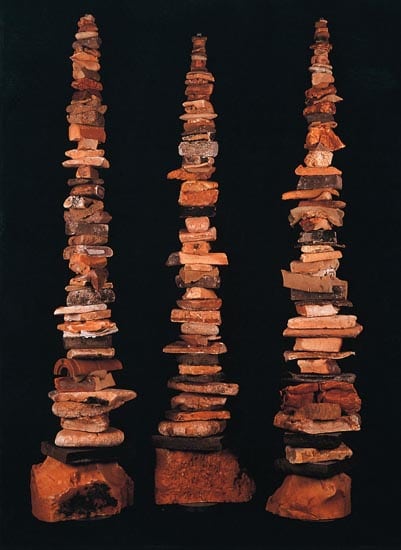
3 Brown Foam Totems 2000

7 Buoy Totems 2000
With all the talk about the new experimental works coming out of Asia, like Yue Minjun’s iconic grinning self-portraits, you would think that the million dollar figures Chinese contemporary art is fetching is the only thing that mattered. An entirely different ethos underpins the multifaceted work
of Australian John Dahlsen, who has been quietly amassing recognition and awards for his unique creations, cobbled together from bits of driftwood and all manner of discarded plastic detritus. After working in abstract painting for years, the Byron Baysider began stumbling across masses of plastic debris while scouring the Victorian coastlines for driftwood to use in furniture. Something of an obsession soon developed, and over the period of a decade, a vast collection of litter from the ocean has been crowding his studio.
Dahlsen attended the respected Victorian College of the Arts in Melbourne in the seventies, and was enthralled by the abstract expressionism of Mark Rothko during a memorable visit to London’s Tate Gallery in 1981. After a stint in the United States, he returned to his home turf and took up a position
as artist-in-residence at Editions Gallery in Western Australia. With his traditional realm of paint and canvas already giving way to explorations with new materials and techniques, the “accident” of coming across a bounty of waste plastic on the beach was all the inspiration needed to transition to a new way of working. “I was immediately affected by a whole new palette of colour and shape revealing itself to me; I had never seen such hues and forms before,” says the artist, who has sifted, sorted and colour-coded his precious finds ever since.
Of that early time, Dahlsen says: “My challenge as an artist was to take these found objects, which might on first meeting have no apparent dialogue, and to work with them until they spoke and told their story, which included those underlying environmental messages inherent in the use of this kind of medium.” As a seasoned artist, Dahlsen could be forgiven for dwelling on the aesthetic, but a deep environmental consciousness clearly has its roots in those early experiences. “By presenting this art to the public it will hopefully have people thinking about the deeper meaning of the work, in particular the environmental issues we currently face,” he says. Of his many exhibitions over the years, perhaps his most important will be in Barcelona, Spain at the 2008 World Conservation Congress organised by the International Union for the Conservation of Nature and Natural Resources (IUCN).
The “environmental” art of Dahlsen attests to the staggering. global problem of trash in our oceans, the majority of which is plastic. In 2006, the United Nations Environment Program estimated that every square mile hosts some 46,000 pieces of floating plastic. So vast is one area of concentrated trash
in the northern Pacific Ocean, confined by slowly circulating currents, that it has been named the Great Pacific Garbage Patch. A Greenpeace report that same year estimated that 80 percent of the ocean’s plastic garbage begins its long life on land. Much of the remainder is spillage directly from the plastics industry, which ships plastic around the globe in the form of tiny pellets, called nurdles, that eventually end up on our supermarket shelves after being coloured, melted and moulded into our ubiquitous disposable products.
Not surprisingly, the ocean’s toxic stew spells untold havoc for ecosystems. A plastic bag is a dead ringer for a jellyfish – if you’re a sea turtle. Multicoloured plastic shards have been found to lace the innards of marine birds. Most insidious of all, the tiniest fragments of plastic are soaking up the manmade toxins already widely diffused in seawater, threatening the entire food chain. We are already ingesting our own trash. The plastic debris that washes up on Dahlsen’s shores and finds its way into his art is a poignant reminder of the crucial part we all have to play.
